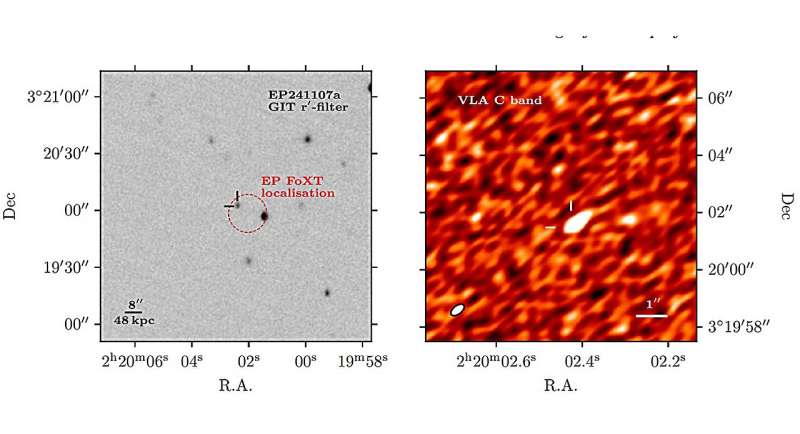Astronomers have identified a potential gamma-ray burst (GRB) origin for a fast X-ray transient designated as EP241107a, following an observational campaign that utilized both ground-based and space telescopes. The findings were published on November 4, 2025, on the arXiv preprint server and highlight the complexities surrounding these brief and elusive cosmic events.
Fast X-ray transients (FXTs) are characterized by their rapid bursts of soft X-rays, typically lasting from several hundred seconds to a few hours. Their unpredictable nature makes them difficult to detect, and their origin remains a subject of debate among scientists. Various hypotheses have emerged, including stellar flares, supernova shock breakouts, and long gamma-ray bursts.
The transient EP241107a was first detected on November 7, 2024, by the Wide-field X-ray Telescope (WXT) aboard the Chinese space telescope, the Einstein Probe, which was launched in January 2024. Initial observations also identified an optical counterpart of EP241107a in the I c-band, recorded at a magnitude of 17.85. Given the uncertainty surrounding the properties of this transient, a team led by Deepak Eappachen from the Indian Institute of Astrophysics in Bengaluru conducted extensive follow-up observations using several ground-based telescopes, including the GROWTH-India Telescope and the Himalayan Chandra Telescope.
Observational Findings and Analysis
The observational campaign revealed a radio counterpart for EP241107a at frequencies of 10 GHz and 6 GHz, with flux densities measured at approximately 232 and 207 μJy, respectively. The spectroscopic redshift of the transient was calculated to be 0.457. When detected, the X-ray luminosity of EP241107a reached around 3.4 quindecillion erg/s within the 0.5-4 keV band, significantly exceeding the expected luminosities for typical supernova shock breakouts.
About 60 minutes after the initial detection, an X-ray afterglow was observed with a luminosity of 0.012 quindecillion erg/s in the 0.5–10 keV band, although this counterpart exhibited a rapid decline. The host galaxy of EP241107a was found to possess a stellar mass of approximately two billion solar masses, coupled with a star formation rate estimated at 0.6 solar masses per year.
The comparison of optical and radio observations with other known extragalactic transients led the research team to suggest that EP241107a is consistent with a gamma-ray burst origin. “We compared the radio and optical light curves of EP241107a with those of other transients and found that EP241107a is consistent with the parameter space occupied by GRB afterglows,” the researchers stated.
Implications for Future Research
Despite the compelling evidence pointing to a GRB origin, the authors of the study caution that the absence of gamma-ray emissions, the inferred on-axis viewing geometry, and the energetics derived from afterglow modeling indicate that EP241107a may represent an intrinsically faint gamma-ray burst. This finding opens new avenues for understanding the nature of FXTs and the mechanisms underlying these transient phenomena.
The research, conducted by Eappachen and his team, emphasizes the importance of multiwavelength observations in characterizing cosmic events. As scientists continue to explore the universe’s mysteries, the insights gained from EP241107a may prove crucial in unraveling the complexities of fast X-ray transients and their origins.
This article was prepared by Tomasz Nowakowski, edited by Stephanie Baum, and reviewed by Robert Egan. It reflects a commitment to rigorous science journalism, aiming to inform readers about significant advancements in the field of astronomy.
